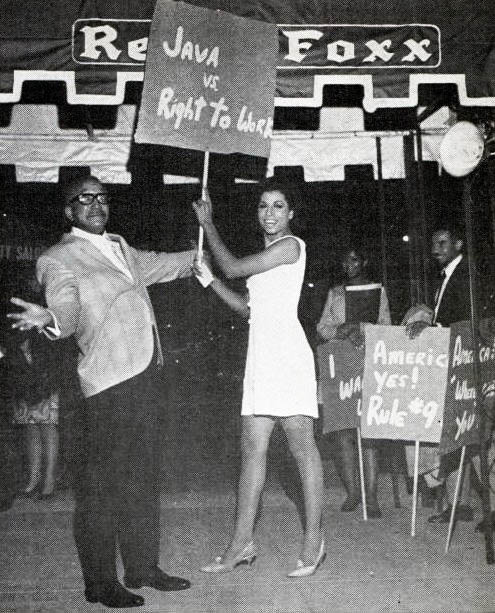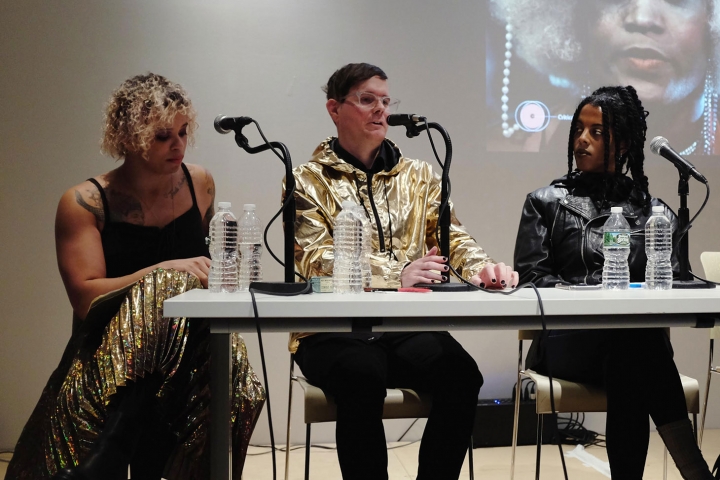Trap Door, on the Contradictions of Trans Visibility
In the midst of the 1960s, Sir Lady Java, a Los Angeles-based Black femme performer and female impersonator, began to gain global prominence. Zealously, her performances questioning visual confirmations of gender (and those of other Black femme performers) drew the eyes of the public and police. Plainclothes officers began appearing at Java’s shows to torment and intimidate her. Gender scholar Treva Ellison recounts in the acclaimed anthology on trans representation Trap Door: Trans Cultural Production and the Politics of Visibility that in 1967 the harassment reached its climax. The Los Angeles Police Commission (LAPC) filed an injunction (a court order requiring a person or organization to stop performing a specific action) against the only Black-owned bar Sir Lady Java performed at, Redd Foxx. The LAPC threatened that if the bar didn’t cancel all of Java’s upcoming performances, Redd Foxx’s business license would be revoked. Java picketed and filed a lawsuit, but the courts overturned her claim—offering her little recourse.

Approximately fifty years after the LAPC injunction entered and exited the public consciousness, Laverne Cox adorned Time magazine’s cover to announce “the transgender tipping point.” Its pages describe popular culture’s “new” ushering in of transgender bodies as the instigator of the transgender civil rights movement. Society at large, it proposed, would offer recognition and accommodation to the trans community through hypervisibility. Paradoxically, the tipping point occurred during a year of heightened anti-trans violence—much of which has been directed at trans women of color.
The lingering continuity of the tipping point coincided with MIT Press and the New Museum’s production of Trap Door, the third publication in their series Critical Anthologies in Art and Culture. As current modes of mainstream representation narrowly define the trans community, the text’s editors, Johanna Burton, Reina Gossett, and Eric A. Stanley, wanted the anthology to produce new and more expansive visual syntaxes. With this mutual desire, they reached out to activists, artists, critical theorists, and art historians (like Che Gossett, Juliana Huxtable, Sarah Ahmed, and Abram J. Lewis) to write on visibility’s liberatory capacity. The resulting twenty-one essays, discussions, and collected histories revolve around the complicated shifts to hypervisibility for the trans community, and trans cultural production’s creation of agency in dominant normative societies.

Hypervisibility is a door, that’s the promise anyways, and through it, the trans community is supposed to gain recognition and accommodation. Each door, however, contains a trap; the assurances of visibility will only be offered under the condition that dominant norms (those of white, straight, cisgender men) are followed. Stanley stated in an interview with Topical Cream, “trans people are expected to embody a knowable identity in the cis-centric and racist world we live in.” While excluding the majority of the trans community from the conversation, these traps “educate” by putting a prescribed set of trans bodies on display. The trans hypervisibility education model gives the newly “enlightened” non-trans populace control through freshly-minted stereotypes and rhetoric. In the anthology contribution “Cautious Living: Black Trans Women and the Politics of Documentation,” activist CeCe McDonald pinpoints the need fulfilled by these traps as a soothing of “society, which acts out in ways that can be even more violent … toward our communities. Or the media helps non-trans people say to themselves, ‘I didn’t understand, and now I still don’t understand, but I’m a good person because I watched this movie.’”
The diverse perspectives of the anthology collectively point to a means of circumventing hypervisibility’s manipulative discreditation and appropriation of trans bodies. These evasions are trap doors, “secret passageways that take you someplace as yet unknown”—new possible (unknowable) futures produced by, or directly with, the trans community. The anthology’s varied modes of knowing construct a partial view of a decentralized network of self-fashioned futures based in healing, safety, beauty, and pleasure. Beauty and pleasure in activism are “often regulated to the space of ‘extra,’” as Stanley describes, but are among the “most powerful tools for transforming the unlivable present.”
Many of the book’s discussions and analyses clarify the importance of this thinking in future-making and archive-building projects. These trap doors can’t be built using methods established by cultural institutions—those spaces are built for the mythical normative bodies of white, straight, cisgender men and violently capture identities outside of them. The few existing institutional trans archives don’t prioritize the accessibility of their content. Their space and rhetoric largely focus on the white transgender community and can be difficult to access. In “One from the Vaults: Gossip, Access, and Trans History-Telling,” Morgan M. Page discusses her podcast, Out From the Vault. Within it, she builds a more pleasurable, accessible, and inclusive archive by telling diverse histories of trans life through salacious gossip and interpersonal relationships.

Like Page’s podcast, social media relies on gossip and interpersonal relationships, but these platforms offer a dichotomy to the trans community. Trans individuals are given the ability to present as they choose while social media’s algorithms produce timelines and newsfeeds filled with images of violence against trans people of color. In “Dark Shimmers: The Rhythm of Necropolitical Affect in Digital Media,” Micha Cárdenas expresses that, for her, numbness is produced from the repetition of outrage and melancholy created in viewing visual media on these platforms. To alter these algorithms, Cárdenas and her research assistants started developing #stronger, a space for trans and gender-non-conforming individuals interested in fitness to share content on existing social media platforms and an in-development iOS app. #stronger prioritizes changing the affective condition social media produces for many in the trans community.
The effects of social media’s algorithms on the trans community are, for many, mirrored in the melancholy, outrage, and exhaustion produced from physical normative spaces. Roy Pérez’s “Proximity: on the Work of Mark Aguhar,” presents Mark Aguhar’s performances, drawings, and writing as the Call Out Queen on her tumblr (Blogging for Brown Gurls) as trap doors for existing in physical misogynistic and white supremacist spaces. In performances like Casting: a Glamour: Peony Piece (2012), she offered relief by creating a vision of how her body would be viewed in a “femme-empowered, brown-centering universe.” Aguhar’s legacy is one of trap doors which unravel the opposing feelings of wanting and not wanting to form attachments within the dominant normative society.

The anthology embraces the conflicting nature of existing in normative space. The book doesn’t attempt to function as a globalizing or abstracted canon of trans cultural production and life, but presents and discusses the varied, nuanced, and unsmoothed ways trans people employ trap doors to exist. It offers that hypervisibility is how people who easily navigate normative space gain agency—it’s not a method for everyone. The trans community is best equipped to heal themselves, give themselves power, create spaces of safety for themselves, and, as some of the book’s contributions suggest, create their own modes of visibility. In “Labor of Werqing it: The Performance and Protest Strategies of Sir Lady Java,” Ellison describes Sir Lady Java’s method of protecting herself when traditional means granted no recourse against police harassment. She (along with many others at the time) reworked the “three piece rule.” By wearing three pieces of traditionally male clothing during her act, Java avoided the threat of injunctions, empowered to continue performing. Reflecting on these “trap doors” of trans cultural history and doing the work of redefining what visibility can mean for the next generation, the anthology opens up to potentials not yet defined—allowing for self-fashioned futures based in healing, safety, beauty, and pleasure.
#Sayhername
Emily Sasmor is a Princeton, New Jersey-based artist and writer.